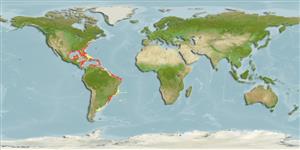Ferosagitta hispida (Conant, 1895)
| Native range | All suitable habitat | Point map | Year 2050 |

|
| This map was computer-generated and has not yet been reviewed. |
| Ferosagitta hispida AquaMaps Data sources: GBIF OBIS |
Classification / Names Common names | Synonyms | CoL | ITIS | WoRMS
Sagittoidea | Aphragmophora | Sagittidae
Environment: milieu / climate zone / depth range / distribution range Ecology
Pelagic; depth range 0 - 685 m (Ref. 116105). Temperate; 45°N - 37°N, 98°W - 20°W
Distribution Countries | FAO areas | Ecosystems | Occurrences | Introductions
Western Atlantic and west coast of Africa.
Length at first maturity / Size / Weight / Age
Maturity: Lm ? range ? - ? cm Max length : 1.1 cm BL male/unsexed; (Ref. 3682)
Only planktonic species raised successfully in laboratories (Ref. 2255). Neritic (Ref. 3682), on bay and nearshore (Ref. 116105). Epipelagic (Ref. 116105). Mean latitude of occurrence = 41 (N); No known presence in China (Ref. 125708).
Life cycle and mating behavior Maturity | Reproduction | Spawning | Eggs | Fecundity | Larvae
Members of the phylum Chaetognatha are hermaphroditic. Mating behavior: A preliminary visual signaling behavior for species recognition is observed to prevent predation. Life cycle: Eggs directly develop into miniature adults (hatchlings).
Main reference
References | Coordinator | Collaborators
Bisby, F.A., M.A. Ruggiero, K.L. Wilson, M. Cachuela-Palacio, S.W. Kimani, Y.R. Roskov, A. Soulier-Perkins and J. van Hertum. 2005. (Ref. 19)
IUCN Red List Status (Ref. 130435)
CITES status (Ref. 108899)
Not Evaluated
CMS (Ref. 116361)
Not Evaluated
Threat to humans
Human uses
| FishSource |
Tools
More information
Age/Size
Growth
Length-weight
Length-length
Morphology
Larvae
Abundance
Growth
Length-weight
Length-length
Morphology
Larvae
Abundance
Internet sources
BHL | BOLD Systems | CISTI | DiscoverLife | FAO(Publication : search) | Fishipedia | GenBank (genome, nucleotide) | GloBI | Gomexsi | Google Books | Google Scholar | Google | PubMed | Tree of Life | Wikipedia (Go, Search) | Zoological Record
Estimates based on models
Preferred temperature
(Ref. 115969): 22.4 - 27.5, mean 25.8 (based on 125 cells).
Price category
(Ref. 80766):
Unknown.



